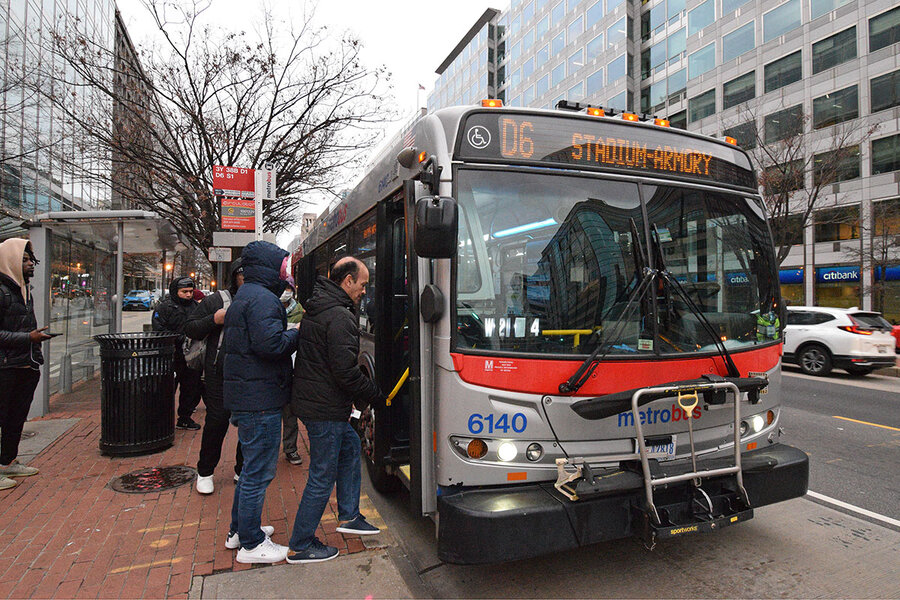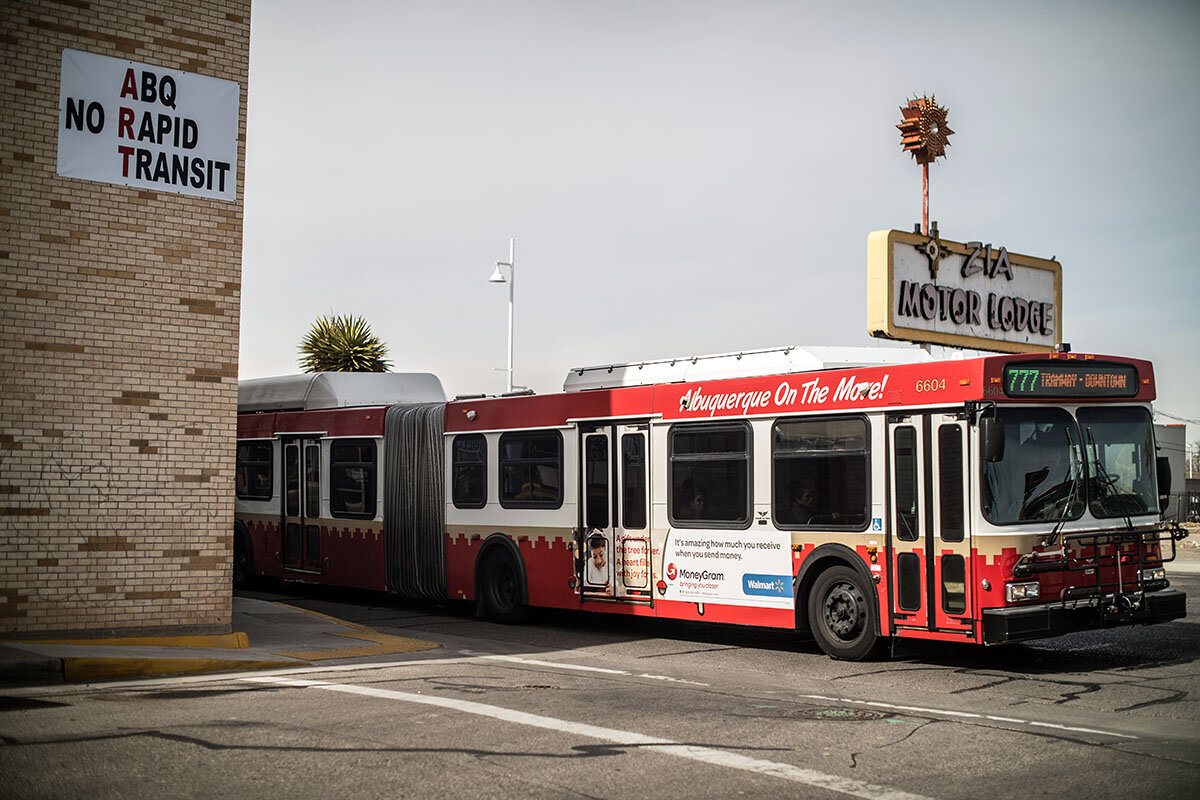Free transit: Is it a public good, like libraries or schools?
Loading...
| Washington
When Rio Bronc leaves her home in the morning to go to her job as a teacher, she aims for an earlier bus than necessary since buses often run late or just don't show up at all. Ms. Bronc depends on the bus for her livelihood – and, in principle, it is a valuable resource. But practically speaking, she spends $20 per week for an unreliable commute.
The city council in Washington, D.C., unanimously moved last month to help thousands of bus stop denizens like Ms. Bronc by making all bus rides originating in the district fare-free starting in July. And in the next 18 months, the district will provide a $100 monthly subsidy for the Metro subway for residents and implement a $10 million expansion of service hours and service to underserved areas.
Public transportation should be considered a public good, just like schools, libraries, and sidewalks, says Charles Allen, the councilmember who introduced the bill, Metro for D.C. “I want to make it so people are able to use it for free.”
Why We Wrote This
A story focused onWashington has become the largest American city to institute free bus fare – an innovation aimed at creating equity for underserved populations. The underlying principle of such programs is to treat mass transit as a public good.
This ethic underlies similar efforts to provide free transit that cities have toyed with for years. In 2020, Kansas City introduced a zero-fare plan covering all bus lines in its metro area in both Kansas and Missouri, and Albuquerque, New Mexico, launched a free-fare pilot program now being considered for renewal. And many – like Boston and Denver – have offered free bus service temporarily and on certain lines.
Metro for D.C.’s free service and improved operations, says Mr. Allen, address two needs: affordability and access. Free transit creates equity for lower-income and minority riders. And investment in better service will improve access in underserved corridors. Further, he says, systems operate faster when riders board without stopping to scan passes or pay fares, and there is less pressure for law enforcement of the petty crime of fare evasion.
And public transit isn’t just an important resource for residents; it’s also key to a healthy economy, generating business that, in turn, produces tax dollars for the city.
Nationwide, 30% of bus riders in 2017 had household incomes of less than $15,000, according to the American Public Transportation Association, and communities of color make up 60% of riders. In the District of Columbia, 68% of residents who ride the bus have household incomes below $50,000, while 51% of district residents who ride the rail have household incomes above $75,000 – and are far more likely to have transit costs subsidized by their workplace.
Reasons not to do it
While advocates of free fares across the country focus on public transit as a “public good” and how best to invest in it, opponents argue that money spent on providing free transit would be better spent on improving service.
There are many valid arguments in favor of and against making public transit free, says Jarrett Walker, a transportation consultant who is not an advocate for or against free transit.
Instead, Mr. Walker favors a holistic view. Bus and rail systems work together, he says, and to charge fares on subways but not on buses as Washington is doing doesn’t optimize the system as a whole: “If you’re going to do free fares, you’re going to need to do it across the board.”
A blanket approach to access is a blunt instrument in building equity, he suggests. For example, some who argue against free fares say there’s “no particular public value in reducing fares for people who can afford [them].”
Another argument is the perception that offering free fares could raise security issues simply by virtue of allowing anyone to board the bus, says Mr. Walker.
Councilmember Allen dismisses the concern that unhoused people, for example, would ride buses all day, saying that isolated incidents shouldn’t jeopardize the entire free-fare program.
“Is the answer to not provide fare-free buses?” he asks. “Or does that mean we should really invest in trying to figure out how that person needs help and help get them housed?”
Free-fare math
Eliminating fare revenue may seem counterintuitive to improving service. But funding differs by city.
In Albuquerque, fares were a relatively small share of the agency’s revenue, says Mr. Walker. For Washington to go fare free is a different situation, because WMATA (bus and rail) received 35% of its budget from fares in fiscal year 2020.
The rest of the budget comes from federal grants and state and local funds. The D.C. Council will compensate for the loss of fare revenue by dedicating some of the district’s increased revenue from a growing economy to fund Metro for D.C., says Mr. Allen.
Whether free fare or lower fare makes more financial sense for a transit system depends in part on scale. For example, some small, rural agencies, says Mr. Walker, spend more on the systems to collect fares than they receive in fare revenue.
In Albuquerque, where fare-free buses have been offered since 2021, the impetus was to remove barriers and build a more equitable transit system coming out of the pandemic, says Megan Holcomb, spokesperson for ABQ Ride.
And, because ridership dropped so dramatically in Albuquerque in the 2020 pandemic, there was hope that free fares would provide a boost to ridership. “We still have a long way to go,” says Ms. Holcomb, “but we are definitely getting there.”
Mostly, feedback has been positive, she says. But her department has received complaints about security issues, because “security issues are kind of relative to ridership” – the more people on the bus, the greater the likelihood of incidents.
Security officers make “proactive routes” around the city, she says, and security issues haven’t risen drastically since free fares.
In Boston, Mayor Michelle Wu has pushed for free-fare buses, enacting them on a temporary basis for certain lines. Free or affordable fares are in the government’s best interest too, says Collique Williams, a community organizer.
For example, when transportation is a barrier that prevents someone from getting to medical appointments, says Mr. Williams, the consequences often “fall back on the state anyways, when folks need emergency services.”
A low-income fare system (providing lower fares to lower-income riders) is the answer for Boston for now, says Mr. Williams, who works for Community Labor United. Not only is it easier for local government to embrace a low-income fare system than free fares right away, but focusing resources on riders in the most need “puts something like $500 [per year] back into the pockets of riders.”
D.C. Councilmember Allen is optimistic that other regions and cities will follow suit with free or affordable fares. Success in the district, he says, “will create pretty significant political will to help move in this direction.”







